Back in 2013, I was introduced to conceptual crochet, and I worked on what has become my favorite super-cold-weather-go-to scarf: my temperature scarf.
This post contains affiliate links.
(You can get the free crochet pattern here, or you can buy the ad-free PDF version on Craftsy. This 7-page booklet includes an overview of temperature crochet projects and tips for planning your own crochet temperature scarf, along with a customizable planning chart/color key and a free crochet pattern for a temperature scarf.)
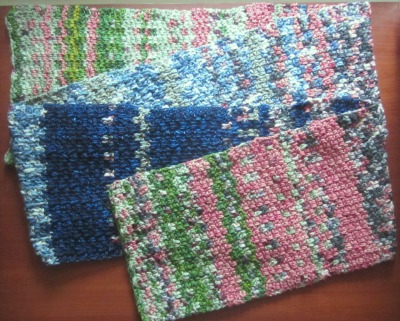 I learned a lot from that project, and as we come to the beginning of another year, I want to share these tips with you to help you plan your own year-long crochet temperature project.
I learned a lot from that project, and as we come to the beginning of another year, I want to share these tips with you to help you plan your own year-long crochet temperature project.
But first, what’s a temperature project anyway?
I first heard about conceptual knitting from the designs of Lea Redmond, an artist and knitting designer. Conceptual projects can just as easily be made using crochet. (If you’re a knitter, you may want to check out Lea’s book, Knit the Sky: Cultivate Your Creativity With a Playful Way of Knitting.)
Conceptual designs help you step outside of your comfort zone and your crochet routine to create unpredictable projects. A finished conceptual crochet project is like an infographic that visually documents a time period. Conceptual crochet projects can be great ways to get over “crocheter’s block,” experiment with colors, or create a unique memento of an important time in your life. (You can find more tips for getting your “crojo” back in this post.)
 The basic idea of a temperature crochet project is that you crochet one row or motif per day over a specific length of time. Your color selection for each day’s stitching isn’t predetermined, but it’s based on a color palette that is linked to a range of temperatures.
The basic idea of a temperature crochet project is that you crochet one row or motif per day over a specific length of time. Your color selection for each day’s stitching isn’t predetermined, but it’s based on a color palette that is linked to a range of temperatures.
Choose a Project
Once you’ve decided to create a crochet temperature project, you’ll also need to get more specific. A simple shape – like a rectangle or square – is best, so projects like scarves, one piece blankets, and modular projects (like granny square blankets) are ideal.
Choose the Pattern, Stitch, or Motif
An existing conceptual crochet design, like my free Temperature Scarf pattern, might be the starting point for your project, or maybe you have a favorite stitch or motif pattern you’d like to use instead.
Before you get started, consider the interplay between the length of your project, the size of your pattern stitch or motif, and the size of the final project. So for a year-long project, a 365 row scarf worked in treble crochet in bulky yarn would be too long to wear comfortably, but a 365 row blanket worked in single crochet might be too short to cover your mattress.
Choose Your Yarns
For my first conceptual crochet project, I picked machine washable yarns that I bought at special events like yarn crawls and fiber festivals. I wanted to use yarn from my stash that had special significance to me. I used a broader range of colors than I usually would for a project, but I picked colors that were harmonious together.

Other crocheters buy yarn specifically for their conceptual crochet projects. When selecting yarn…
- Aim for consistency in care instructions for ease of washing.
- Remember that since you aren’t planning striping and color placement in advance, each yarn should look harmonious when paired with another yarn in your project. Keep in mind the quilter’s adage and use at least seven colors.
- You may find that using yarns from the same company makes it easier to find colors that coordinate easily.
- Keep in mind that you can’t predict how much of each yarn you might use. For example, I used up an entire skein for one temperature range and had to choose another yarn partway through my project, but I only crocheted two rows with another skein!
Create a Color Key
Once your yarns are selected, create a color key that matches each yarn to a temperature range. Each yarn may be a literal representation of the temperature, like red for warmer temperatures and white for colder temperatures, or you can just choose colors you like! You’ll use the key to determine which yarn to use for any given day’s crochet.
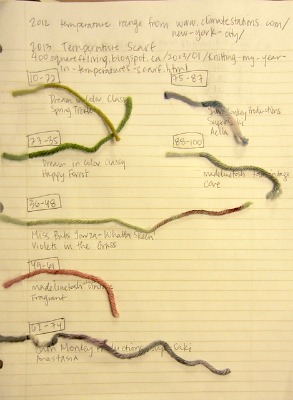
Before setting up my key, I looked at the average temperature range during the previous year in my city, and divided that by the number of yarns I wanted to use. That’s how I was able to choose the number of degrees each yarn should represent.
Once you have your yarn, stitch or pattern, and project selected, and your key is set up, you’re ready to start your temperature project!
Shop for Crochet Motifs and Granny Square patterns on LeisureArts.com.
Stay Motivated
Some crocheters find that working one row or motif each day is an easy commitment to keep. I didn’t! So I recorded the daily temperatures on a notepad that I referred to later. You could also list the temperatures on your Ravelry project page and refer to it when you have time to crochet.
When I was crocheting my temperature scarf, I couldn’t keep up with the project on a daily basis, so I would crochet about 30 rows once a month for most of the year.
Some crocheters find that joining an online crochet-a-long group helps them to stay motivated and accountable. Others find that setting aside a few minutes a day for crochet makes the project more manageable.
Whenever you’re losing motivation, remember that a finished conceptual crochet project is always a great conversation starter!

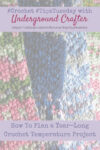
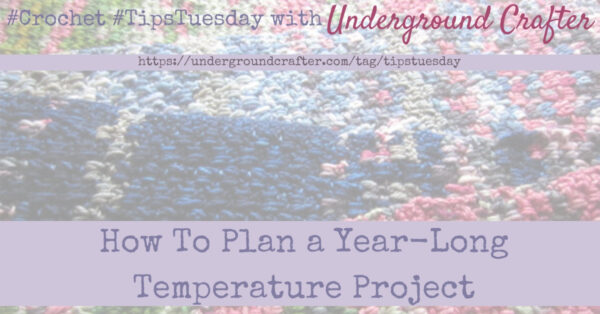
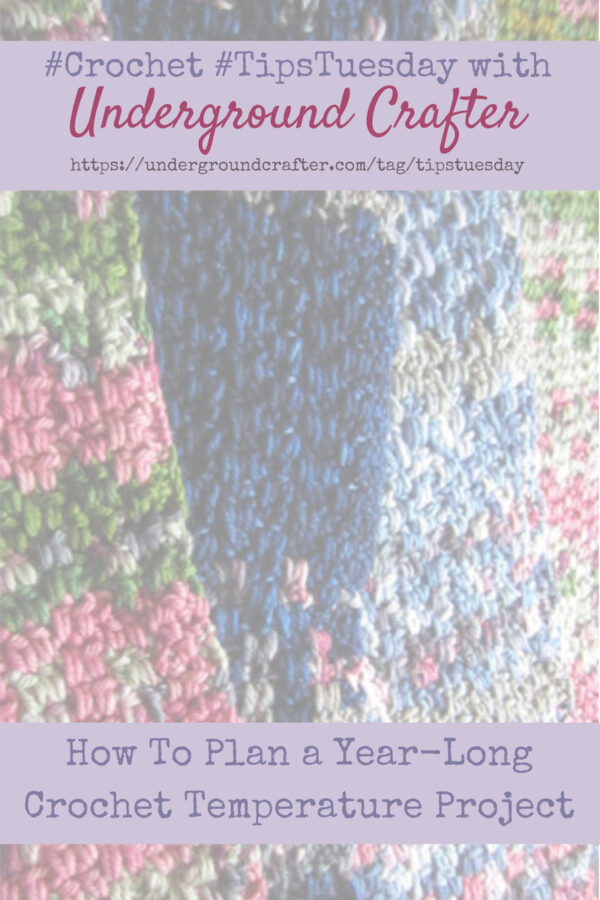


Thank you for sharing these tips! This idea has always intrigued me!!!!
It’s pretty fun, Darlene! If you make one, let me know.
Knitted the 2015 temperature with great results enjoyed the project so much I have started a combination sky and temperature crochet project for 2016
Oooh, sounds fun, Grandma Snyder! Thanks for sharing your variation.
I’m a knitter but would like to freshen & extend my crocheting skills with a temperature blanket. Don’t know the best way to weave in ends of rows for all the color changes. Are there any tips?
Thanks for stopping by, Karen! I don’t currently have tips posted for the color changes, but I can work on that. I would recommend leaving the color unchanged until you know the next day’s temperature. You may not need to change it as often as you’d think.
I have 2 (!!) of these going at the moment. One for me (its a block for each month, with black in between each day to make the number of rows. The other I started for a wonderful friend of mine that got married in January. Hers is from the day of her marriage to their first anniversary. That one is a row a day (380 stitches) it will be large enough to cover a king bed with drape. it will go from one side to the other (hence the 380 stitches!) Our weather in NJ has been insane so the colors jump about, but I think I love it like that! I too am recording the temperatures and working a few rows at a time, some days hers, some mine. I did have to change the pattern for mine or it would have been a HUGE rug! I loved the pattern I started with, but alas… WAY huge!
Oooh, these sound like a lot of fun, Jenn! I especially like the marriage through first anniversary idea.
Would you mind sharing the pattern you’re using for the anniversary gift? I can’t find one that would be big enough to do cover at least queen size bed . are you crocheting more than one row a day to make it large enough?
I am a fairly new crocheter and I have been wanting to make a blanket but I guess I am kind of impatient. Lol. I think this temperature or a mood blanket would be great. I can do a row or two a day and still do some smaller projects too. Thank you for the great tips!!!
Suggestions for Phoenix, AZ Temps? How to break up our 105-111 days that occur most of summer? I really want to make one of these vut noy sure I can get enough variation to make it interesting.
Lisa, I would recommend that you create a color key that isn’t evenly divided. For example, perhaps in the common, hotter temperatures, the colors change every 3-5 degrees while in the less common, colder temps they change every 10-20 degrees. You could also choose a multicolor yarn for the common, hot temps.
I started mine this week for 2017. I am using the “mean” temperature as a novelty. I use the Weather Underground website to get the information daily. I started 9 days late, so it is a good place to get the history. I saw how you can also get any year you want, so It would be fun to choose the year a person was born to make as a gift.
Lion Brand just this week, had a blog about crocheting a temperature blanket. They offer a color chart for a guide for the different temperature ranges. They also had a link where you can put in a year and a zip code to get a print out of the temperatures in that zip code for that entire year. I’m going to make a blanket for my son for the year he was born. How far back you can get the temps info varies as to when the area started to record the daily temp.
These were great tips. I’m going to start a temperature blanket in January. I’m excited to try. Now to just pick my colors! Thinking 8 varying shades of purple and maybe blue? I enjoy your blog! Thank you!
Thanks, Kristin! I love the idea of purples and blue for a temperature blanket.